Introduction of System Analysis and Design
SAD is a process for analyzing an organization's needs and designing new information systems to meet them.

What is System Analysis and Design?
System Analysis and Design (SAD) is a structured process used to develop and maintain information systems. It involves analyzing a problem, designing a solution, and implementing that solution using system components like hardware, software, data, and users.
Purpose of SAD:
- To build efficient and reliable information systems.
- To solve organizational problems through technology.
- To ensure system requirements are correctly gathered and implemented.
Nature of System Analysis and Design
|
Feature |
Description |
|
✅ Problem-Solving |
Identifies real-world issues and builds solutions |
|
✅ Logical Thinking |
Focuses on how data flows and processes happen |
|
✅ User-Centered |
Always considers user needs and feedback |
|
✅ Structured & Methodical |
Follows a step-by-step process (analysis → design → development) |
|
✅ Dynamic |
Adapts to changes in technology and requirements |
Diagram: System Analysis and Design Process

Scope of System Analysis and Design
- Requirement Analysis
- Understanding what the user really needs
- Interviewing stakeholders
- Creating requirement documents
- Feasibility Study
- Can we build the system with the available time, money, and technology?
- System Modeling
- Using DFDs, flowcharts, ER diagrams to represent the system
- Designing System Architecture
- Front-end design (interface)
- Back-end design (database, logic)
- Testing and Validation
- Ensuring the system works correctly
- Implementation and Maintenance
- Installing, training, and updating the system
Real-Life Example of System Analysis and Design (SAD)
Example: Online Library Management System
Imagine your college library wants to shift from a manual register system to a digital system to manage:
- Book issuing/returning
- Student membership
- Fine calculation
- Book inventory
To build this, we follow System Analysis and Design (SAD) steps:
System Analysis (SA):
- What does the current manual system do?
- What are the problems? (e.g., lost records, late returns, errors in fine)
- What are the requirements? (e.g., barcode scanning, student login, SMS alerts)
System Design (SD):
- Create data flow diagrams
- Decide UI layouts (login screen, book search, issue/return form)
- Plan database design (students, books, transactions)
- Choose technology (web app, mobile app, cloud storage)
Other Examples of SAD:
|
System |
Use of SAD |
|
School ERP System |
Manage students, fees, attendance, results |
|
Hospital Management System |
Appointments, patient records, doctor schedules |
|
Banking System |
Money transfer, ATM services, user authentication |
|
E-commerce Site |
Inventory, orders, payment gateway, delivery tracking |
|
Payroll System |
Employee records, salary calculation, tax deduction |
Why SAD is Important
|
Reason |
Example |
|
✅ Saves Time and Money |
A well-analyzed system avoids costly rework |
|
✅ Improves User Satisfaction |
Meeting real needs, not assumptions |
|
✅ Supports Decision-Making |
With clear data and reporting systems |
|
✅ Enhances Efficiency |
Automation reduces manual work and errors |
Final Thoughts
System Analysis and Design is not just coding, it's about understanding problems, planning smart solutions, and delivering real benefits to users and organizations.
-----------------------------
Files
What's Your Reaction?















